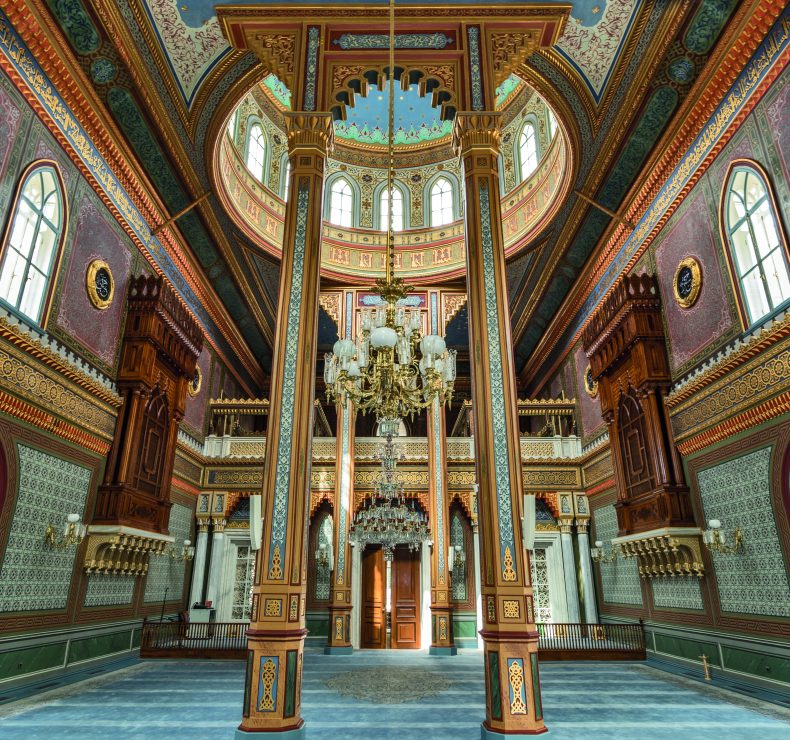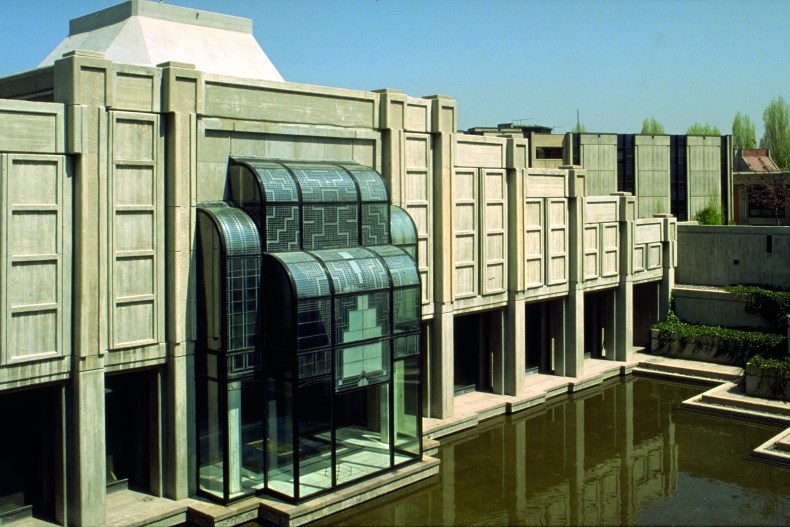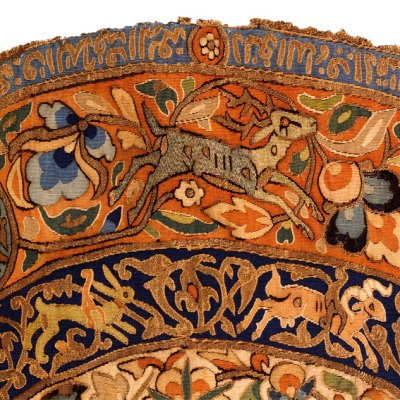One Friday in August this year, Turkey’s president, Recep Tayyip Erdogan, knelt before the qibla – an ornamented niche pointing towards Mecca – in the Yildiz Hamidiye Mosque, to mark its spiritual reopening after restoration. This modestly proportioned, T-shaped building stands outside the gates of the wooded palace complex from which it takes its name; ‘Yildiz’ meaning star, the suffix ‘Hamidiye’ being a reference to Abdulhamid II, the Sultan-Caliph for whom it was built.
The admiration of Turkey’s current president for the Ottoman Empire is well known, and his tenacity in maintaining power has been compared to that of Abdulhamid, who dodged democrats, would-be assassins, and grasping European powers for 33 years before finally succumbing to a military coup in 1909. But in the speech that Erdogan delivered after finishing prayers, he barely mentioned the mosque, and the sultan not at all. Instead, having delivered one of his usual broadsides against impious foreigners, he plugged a bigger and more monumental mosque, his mosque, the colossal minarets of which were recently erected on a famous old hill on the opposite bank of the Bosporus. The new Camlica Mosque, he promised, would be the country’s ‘number one’, perhaps even eclipsing the vast inventory of Ottoman religious architecture.
That Erdogan should be more interested in talking up his mosque than that of an earlier Turkish ruler is perhaps not surprising, but there is more to this than competitive preening. The Camlica Mosque is a huge box attached to a colonnaded courtyard; on top of the box, domes and half-domes swarm around a squat central dome surmounted by a golden, crescent-shaped finial. Everyone in Turkey knows what this means: it is a homage in concrete, steel, and no doubt a great many durable polymers, to Mimar (literally ‘architect’) Sinan, chief builder of the Ottoman classical age.
The Camlica Mosque in Istanbul, due to be completed in 2018, has been designed to hold around 37,000 worshippers. Photo: Chris McGrath/Getty Images

Eighty per cent complete, Camlica stares presumptuously at the most magnificent of Sinan’s Istanbul creations, on the Thracian shore of the Golden Horn. Named after Suleyman the Magnificent, who reigned between 1520 and 1566, the Suleymaniye shows off Sinan’s gift for creating huge but coherent domed spaces – after he had absorbed all he could from the Byzantines who had formed the city when it was Constantinople. As a symbol of Turkish culture in its mature form, the silhouette of an imperial Sinan mosque is unbeatable.
There is arguably no strand of thought and creativity linking Sinan and the architects of Camlica; the latter is factory-made and its use of concrete has relegated Sinan’s structural devices – the dome-clusters, for example, that he used to diffuse the downward thrust of the main dome – to mere ornament. But it is Camlica that stands the taller (in part thanks to the hill) and it boasts six minarets to the Suleymaniye’s four. When it is fully operational, around the end of 2018, it will have room for around 37,000 worshippers and will provide, in addition to libraries and conference rooms, fantastic retail.
One can understand why Turkey’s religious nationalists, seeking a new golden age, should look to the 16th century, when the empire ruled much of the earth and the combination of mosque, religious school, and caravanserai formed an architectural trinity that was exported to the Balkans and the Levant. Ever since the current revival of mosque-building got underway in the 1990s, Sinan’s box and dome model has enjoyed a stylistic monopoly. Dumpy little versions have gone up around the country, their domelets covered by hideous rain-resistant, zinc-plate coating, and the minarets just for show (nowadays the muezzin is an iTunes download).
In the 1990s, Turkey’s ruling establishment was dominated by secularists who rubbished the ‘backward’ Ottoman Empire and disapproved of the new mosques. These secularists were followers of the founder of the modern Turkish Republic, the hard-drinking positivist Mustafa Kemal Ataturk. But since Erdogan and his Islamists came to power in 2002 the opposite view has gradually prevailed. Nowadays he and his ministers disparage Ataturk and nostalgically recall Ottoman military might. Friday prayers are de rigueur, and foreign policy is periodically – if not always successfully – refocused at re-establishing Turkish influence in former Ottoman lands.
There has been a revival of ‘soft’ Ottomanism, from the ornamental ewers, encrusted mirrors, and chased Ottoman candlesticks produced by the home-decoration giant Pasabahce, to the introduction of Ottoman specialities such as almond and nutmeg soup on to restaurant menus. Since 2006 Istanbul has played host to an annual tulip festival (tulip mania consumed the Ottoman polite classes for a period in the 18th century), while kutnu, ‘palace cloth,’ a blend of silk and cotton, figures in the collections of fashion designers such as Bora Aksu. And now, in the Camlica mosque, which looms over the entrance to the Bosporus, visible from miles around, Sinan revivalism has become as important as Sinan himself.
The interior of the Yildiz Hamidiye Mosque in Istanbul, commissioned by Abdulhamid II and completed in 1886. Photo: Salvator Barki/Getty Images

Which brings us back to the eclectic, un-cavernous Hamidiye on the other side of the straits. It has been restored, but the ruling classes do not love it, and its visitors will mostly be tourists. Hamidiye reflects a quite different Ottoman reality to Camlica and the Suleymaniye. The empire under Abdulhamid was mired in debt and late Ottoman culture was shot through with Western fashions – from collars and table manners to novels and socialism. Atop this fragile edifice sat a sultan who rarely ventured from his palace for fear of assassination; so, rather than cross the Golden Horn to the great imperial mosques, as his predecessors had done, Abdulhamid built one nearer to home. The Hamidiye was the private project of this reclusive sultan and amateur cabinet-maker; its latticed bay windows and the wooden roundels between the clerestory windows are his own work.
Between 1886, when the Hamidiye was finished, and 1909, the sultan’s weekly trips from palace gate to mosque and back again were almost his sole public appearances. Each Friday the soldiers lining the 50-yard route in their red fezzes called ‘Long Live our King!’, the muezzin sang out the call to prayer, and the foreign ambassadors in full dress scrutinised his features as he sat in the passing victoria for signs of stress. And assassins plotted; in 1905 a powerful bomb timed for his exit from Friday prayers exploded while he was still in the mosque, killing 28 people.
The private oratory of the caliph of Islam wasn’t built by a Muslim, but by the Armenian Christian Sarkis Balyan, a member of a family of court architects . The Balyans knew Western fashions and the heritage of Constantinople alike; here is a mosque with Gothic Revival windows reminiscent of Horace Walpole’s house at Strawberry Hill, while the lantern dome (made of wood) is clearly of Byzantine inspiration. With its lobed arches, muqarnas, or honeycomb, decoration, and blue, yellow, and red colour scheme, the warm interior chamber was influenced by the 19th-century European mode for Moorish Spain. The Hamidiye’s blue dome, spattered with stars, has been compared to that of the Wilhelma Palace in Stuttgart. Delightful though it is, the Hamidiye is neither large nor stridently Turkish; it doesn’t tick many modern Islamo-nationalist boxes.
Another alternative to neo-Ottomanism is to toss away the old vocabulary of mosque-building altogether. This is evidently what Behruz and Can Cinici felt in the late 1980s when this father and son architectural team built a mosque for the parliament in Ankara. Ataturk had conceived his new capital on the Anatolian steppe as the antithesis of imperial Istanbul – rational, austere and useful – and the Austrian architect Clemens Holzmeister built a complex of legislative buildings that was all these things. Many Turkish Islamists saw in the Cinicis’ later addition a quintessentially Kemalist response to unwelcome piety: a mosque that looked like anything but a mosque, and certainly not a Sinan mosque.
The Grand National Assembly Mosque in the parliament complex in Ankara, designed by Behruz and Can Cinici and completed in 1995. Photo: Reha Günay; courtesy Aga Khan Trust for Culture

When I was a journalist in Ankara in the late 1990s, I would often visit this serene and harmonious building after visiting members of parliament. Ranged along one side of a shallow courtyard, its stepped roofline rising like a ziggurat, it looks sacred but not particularly Islamic. Entering the building, which is wide but shallow, one is surprised to find the interior suffused by light entering from windows cut into the steps of the pyramid, while the play of concrete cut-ins creates a kind of muqarnas en brut. The mosque is backed by a glass qibla wall looking on to a sunken garden, while the imam’s pulpit has sprouted into a full-length, transparent kiosk, animated by modernist stained glass. Other innovations include the near elimination of any obvious division between male and female prayer areas (just a low platform for the women). I was once told that I could enter with my shoes on, an absolute taboo in other mosques.
Even before the mosque was built, the Cinicis were pestered with demands for a dome and a minaret. Behruz Cinici would reply, perhaps a little mischievously, that minarets were in fact an innovation derived from Christian clock-towers in the Levant, and ‘counter to our religion’. At length a compromise was found: a tall cypress, planted between the mosque and adjacent library. In 1995 the Aga Khan’s foundation awarded the Cinicis its coveted architecture prize.
Precisely because of its admirable qualities of taste and restraint, the Cinicis’ mosque is seriously out of step with the neo-Ottomanism of the Erdogan regime. Its future is now under question in the aftermath of the coup attempt of 15 July 2016, in which the president’s life was threatened, but which in the end led to a surge in his popularity. One of the most shocking episodes of 15 July was the aerial attack that the putschists launched on the parliament building – F-16s screaming overhead and rockets slamming into the home of Turkish democracy. When I visited a few weeks later, parts of Holzmeister’s parliament building were all gnarled stanchions and shattered stone.
In the course of the attack on the parliament a public relations office, also designed by the Cinicis, was damaged and has since been torn down. This has led to worries on the part of Turkey’s dwindling but nonetheless vocal secularists that their mosque will also be found to have sustained ‘damage’, paving the way for its demolition. A successful campaign by prominent architects to have the mosque declared a cultural asset has been taken to appeal by the Culture Ministry; the case is now before the highest administrative court in the land. ‘They evidently want to tear down an award-winning mosque and replace it with a pretentious one,’ the head of Ankara’s chamber of architects said recently. Catch it while you can.
From the November issue of Apollo. Preview and subscribe here.


